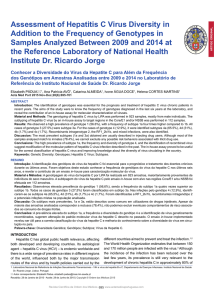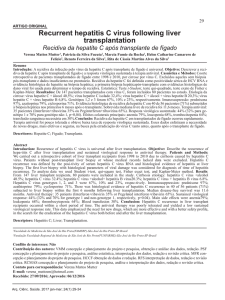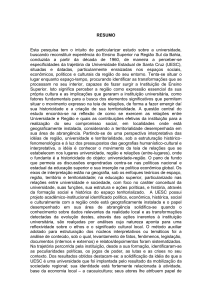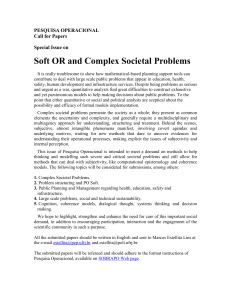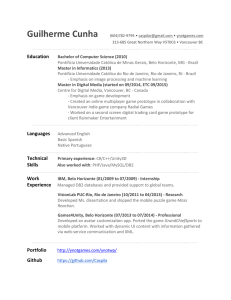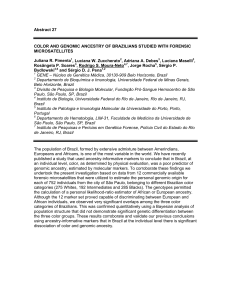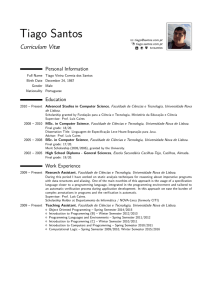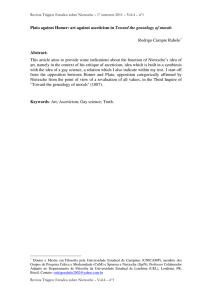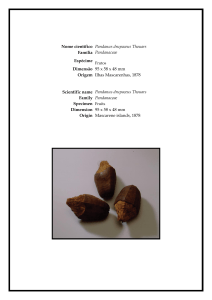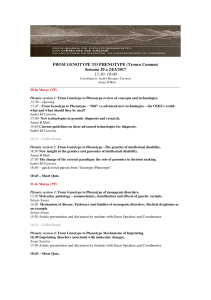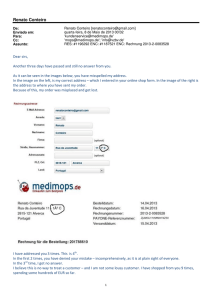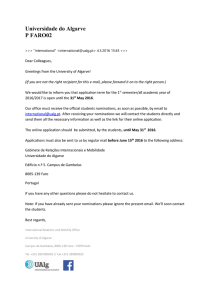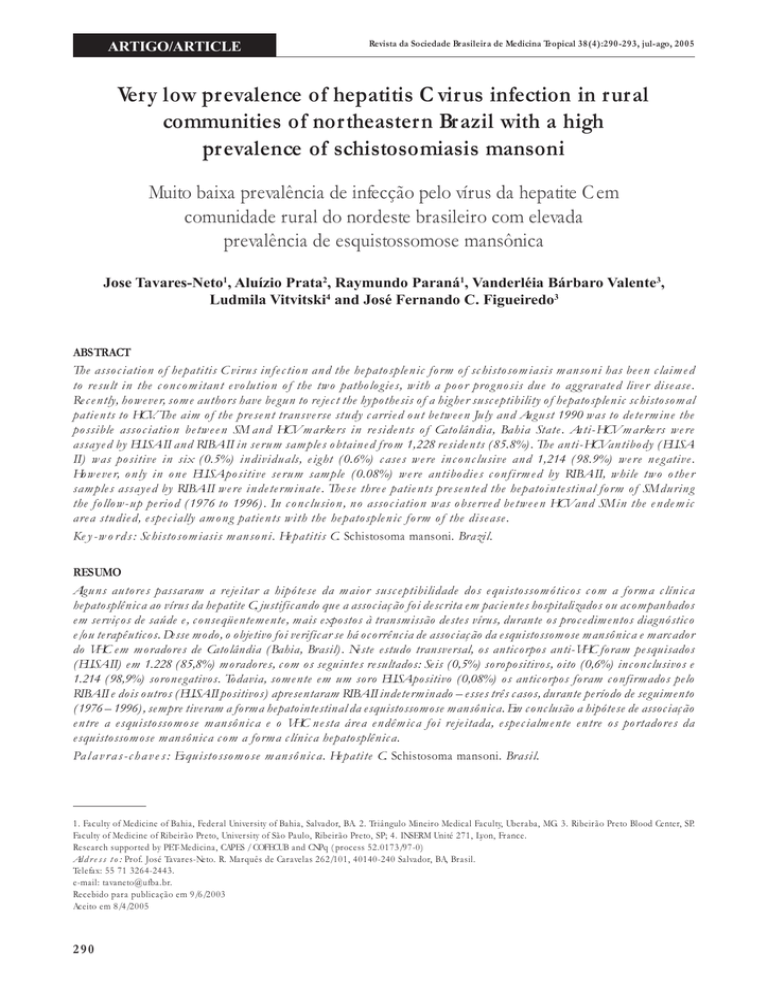
ARTIGO/ARTICLE
Revista da Sociedade Brasileira de Medicina Tropical 38(4):290-293, jul-ago, 2005
Very low prevalence of hepatitis C virus infection in rural
communities of northeastern Brazil with a high
prevalence of schistosomiasis mansoni
Muito baixa prevalência de infecção pelo vírus da hepatite C em
comunidade rural do nordeste brasileiro com elevada
prevalência de esquistossomose mansônica
Jose Tavares-Neto1, Aluízio Prata2, Raymundo Paraná1, Vanderléia Bárbaro Valente3,
Ludmila Vitvitski4 and José Fernando C. Figueiredo3
ABSTRACT
The association of hepatitis C virus infection and the hepatosplenic form of schistosomiasis mansoni has been claimed
to result in the concomitant evolution of the two pathologies, with a poor prognosis due to aggravated liver disease.
Recently, however, some authors have begun to reject the hypothesis of a higher susceptibility of hepatosplenic schistosomal
patients to HCV. The aim of the present transverse study carried out between July and August 1990 was to determine the
possible association between SM and HCV markers in residents of Catolândia, Bahia State. Anti-HCV markers were
assayed by ELISA-II and RIBA-II in serum samples obtained from 1,228 residents (85.8%). The anti-HCV antibody (ELISAII) was positive in six (0.5%) individuals, eight (0.6%) cases were inconclusive and 1,214 (98.9%) were negative.
However, only in one ELISA-positive serum sample (0.08%) were antibodies confirmed by RIBA-II, while two other
samples assayed by RIBA-II were indeterminate. These three patients presented the hepatointestinal form of SM during
the follow-up period (1976 to 1996). In conclusion, no association was observed between HCV and SM in the endemic
area studied, especially among patients with the hepatosplenic form of the disease.
Key-words: Schistosomiasis mansoni. Hepatitis C. Schistosoma mansoni. Brazil.
RESUMO
Alguns autores passaram a rejeitar a hipótese da maior susceptibilidade dos equistossomóticos com a forma clínica
hepatosplênica ao vírus da hepatite C, justificando que a associação foi descrita em pacientes hospitalizados ou acompanhados
em serviços de saúde e, conseqüentemente, mais expostos à transmissão destes vírus, durante os procedimentos diagnóstico
e/ou terapêuticos. Desse modo, o objetivo foi verificar se há ocorrência de associação da esquistossomose mansônica e marcador
do VHC em moradores de Catolândia (Bahia, Brasil). Neste estudo transversal, os anticorpos anti-VHC foram pesquisados
(ELISA-II) em 1.228 (85,8%) moradores, com os seguintes resultados: Seis (0,5%) soropositivos, oito (0,6%) inconclusivos e
1.214 (98,9%) soronegativos. Todavia, somente em um soro ELISA-positivo (0,08%) os anticorpos foram confirmados pelo
RIBA-II e dois outros (ELISA-II positivos) apresentaram RIBA-II indeterminado – esses três casos, durante período de seguimento
(1976 – 1996), sempre tiveram a forma hepatointestinal da esquistossomose mansônica. Em conclusão a hipótese de associação
entre a esquistossomose mansônica e o VHC nesta área endêmica foi rejeitada, especialmente entre os portadores da
esquistossomose mansônica com a forma clínica hepatosplênica.
Palavras-chaves: Esquistossomose mansônica. Hepatite C. Schistosoma mansoni. Brasil.
1. Faculty of Medicine of Bahia, Federal University of Bahia, Salvador, BA. 2. Triângulo Mineiro Medical Faculty, Uberaba, MG. 3. Ribeirão Preto Blood Center, SP.
Faculty of Medicine of Ribeirão Preto, University of São Paulo, Ribeirão Preto, SP; 4. INSERM Unité 271, Lyon, France.
Research supported by PET-Medicina, CAPES / COFECUB and CNPq (process 52.0173/97-0)
Address to: Prof. José Tavares-Neto. R. Marquês de Caravelas 262/101, 40140-240 Salvador, BA, Brasil.
Telefax: 55 71 3264-2443.
e-mail: [email protected].
Recebido para publicação em 9/6/2003
Aceito em 8/4/2005
290
Tavares-Neto J et al
Several lines of evidence have favored an association between
hepatitis B virus (HBV) infection and the hepatosplenic form of
schistosomiasis mansoni (SM)26. More recently, however, this
association has been revised6 24 29, with the conclusion that it is
due to a greater exposure to HBV rather than to a higher
susceptibility of individuals with SM to hepatotropic viruses, i.e.,
HBV and hepatitis C virus (HCV).
Despite phylogenetic differences between HBV and HCV, their
mechanisms of transmission show some similarities11. Thus, one
might speculate that HCV infection is associated with SM,
especially among patients with the severe hepatosplenic form of
the disease.
Before the HCV era, some patients with hepatosplenic
schistosomiasis and a histopathology compatible with chronic
viral hepatitis did not present HBV markers in serum or hepatic
tissue16 17. Similar findings have been reported in Brazil by
Andrade et al3 4.
After characterization of HCV by Choo et al 7 and the
consequent possibility of detecting HCV markers in serum, Lins16
showed that the frequency of individuals with anti-HCV antibodies
does not differ between patients with the hepatointestinal form
of SM and those with the hepatosplenic form.
Other authors 1 2 5 8 10 12 13 14 15 31 have provided evidence
suggesting that the presence of anti-HCV antibodies is associated
with schistosomiasis, but contradictory data exist. However, it
should be noted that these authors used different serologic
methods. In addition, these studies were conducted on patients
recruited from referral centers and not from rural Brazilian
communities where Schistosoma mansoni is endemic.
Based on the clinical and immunological peculiarities of
SM and hepatitis C in Brazil, the aim of the present study was
to determine the possible association between the two
diseases in an area endemic for SM.
RESULTS
MATERIAL AND METHODS
Gender
male
585 93.8
20
3.1
23 3.7
χ2=1.18*
female
580 89.9
46
7.1
19 3.0
p>0.26
Mean age (m ± SD) 23.6 ± 20.4
33.4 ± 18.5
35.2 ± 17.4
**
Place of residence n(%)
urban
640 89.3
41
5.7
36 5.0
χ2=15.27*
rural
625 94.4
25
4.5
6 1.1
p<0.0001
* Mantel-Haenszel test; ** HI vs AHI: t=-3.79, p<0.0001 (F=1.22, p>0.29); HI vs HS:
t=-3.62, p<0.0001 (F=1.39, p>0.18); AHI vs HS: t=-0.51, p>0.60 (F=1.13, p>0.67).
A cross-sectional population-based study was conducted on
residents from an SM endemic area in the county of Catolândia29,
which is located in the western region of the State of Bahia, Brazil
(12º8' latitude South and 44º52' longitude West of Greenwich).
A longitudinal study on the morbidity of SM was started
in the study area in 1976, and since then the clinical forms
of the disease were classified according to the criteria of
Prata 22 24 . In addition, the clinical involution of the
hepatosplenic forms of SM after antiparasitic treatment was
observed along the study 24 30.
Anti-HCV antibodies were screened using a secondgeneration enzyme immunoassay kit (ELISA-II, Abbott ,
Chicago, IL, USA)31. Anti-HCV-positive sera, those providing
doubtful results were tested by a second-generation
recombinant immunoblot method (Ortho Diagnostic Systems
Inc, Emerville-CA, USA).
Clinical examination of the patients was carried out
without knowledge of the anti-HCV result.
Of the 1,432 residents in the study region, 1,228 (88.9%)
provided complete information and were tested for anti-HCV.
Table 1 and Table 2 summarize the demographic characteristics
(gender and age) and the frequency of different clinical forms
of SM in this population.
Table 1 - Demographic characteristics (gender and age) of the population
from Catolândia, according to place of residence (rural or urban).
Characteristic
Gender
male
female
Age group
00|| 7
08||15
16||23
24||31
32||39
40||47
48||55
56||63
64||90
Mean age (µ ± SD)
Population
urban (n= 717)
rural (n=556)
n°
%
n°
%
348
369
48.5
51.5
162
22.6
181
25.2
85
11.9
75
10.0
72
10.0
45
6.3
40
5.6
19
2.7
41
5.7
23.6 ± 19.6
280
276
50.4
49.6
102
18.3
148
26.6
86
15.5
45
8.1
28
5.0
45
8.1
36
6.5
20
3.6
46
8.3
25.7 ± 21.4
Statistics
χ21=0.35
p>0.54
χ28=23.07
p<0.003
t=-1.78*
p>0.07*
* F test=1.20, p<0.002, degrees of freedom=1137.35.
Table 2 - Distribution of the clinical forms of schistosomiasis mansoni in
the population from Catolândia, according to gender, age and place of
residence.
Characteristic
hepatointestinal
HI (n=1,165)
Clinical form n (%)
advanced HI hepatosplenic
AHI (n=66)
HS (n=42)
Statistics
With respect to the presence of anti-HCV antibodies, six
(0.5%) patients were positive, eight (0.6%) were inconclusive,
and 1,214 (98.9%) were negative.
In only one sample of 14 tested (6 positive, 8 inconclusive)
by ELISA-II commercial Kits (Boehinger-Germany) anti-HCV was
confirmed by the RIBA-II test (Chiron, Emerville, CA). Two (0.2%)
individuals presented results classified as indeterminate by RIBA-II
(both showing antibodies against the recombinant protein c100-3).
All six residents presenting anti-HCV antibodies, as well as
the eight individuals with inconclusive results, as determined by
ELISA-II, had the hepatointestinal form of SM, with the age of
these patients ranging from 5 to 66 years (18.9 ± 9.4).
291
Revista da Sociedade Brasileira de Medicina Tropical 38(4):290-293, jul-ago, 2005
DISCUSSION
Despite massive anti schistosomal treatment and improved
sanitary conditions, the frequency of schistosomal infection
continues to be high in this area. Progressively higher frequencies
of individuals excreting S. mansoni eggs among those seeking
the Catolândia public health service were observed during the
period from 1993 (35.8%) to 1996 (65.4%)29. Thus, SM was
the main cause of morbidity and mortality in Catolândia until the
mid-eighties30. The hepatosplenic form was diagnosed in 187
(8.3%) registered residents (n=2,241) during the study period
from 1976 to 1996.
Although the population of Catolândia shows a reasonable
geographic and cultural isolation27 28, temporary residence and/or
occupation in other states are frequent; for example, during the
study period 273 (12.2%) of the 2,241 individuals registered
migrated28.
In the early eighties, residents from Catolândia commonly
underwent medical treatment in some nearby capitals. Thus, a
temporary migratory flow might have facilitated the introduction
or increased dissemination of HCV in the region, where the lack
of health services represents another characteristic predisposing
to the use of parenteral medication under inadequate conditions,
a fact that could also have contributed to the dissemination of
HCV in many regions of Brazil.
Based on the fact that this region is hyperendemic for
SM, with patients developing upper gastrointestinal bleeding
by rupture of the esophageal varices and receiving blood
transfusions when treated at larger centers, the introduction
and dissemination of HCV can be expected in this region.
The finding of the present study of only one individual with
anti-HCV and without a history of travel to or residence in other
towns supports the hypothesis that in this endemic SM area the
risk of transmission of HCV was not increased. In addition, the
seroprevalence of anti-HCV antibodies observed for residents from
Catolândia was lower than the 1.7% prevalence estimated for blood
donor candidates from the metropolitan region of Salvador, capital
of the State of Bahia (Santana et al, unpublished data).
Silva et al25 observed a 1.2% prevalence of anti-HCV antibodies
in individuals from the metropolitan region of Salvador, and a
0% prevalence of anti-HCV in a populational study carried out in
the rural area of the State of Bahia, Northeast of Brazil. Other
studies concerning the seroprevalence of HCV in the State of
Bahia were carried out on populations at risk of acquiring HCV
infection19 23, while there were no populational studies. However,
the results reported by Silva et al indicate a very low prevalence
of HCV among residents of rural communities also endemic for
S. mansoni infection.
Based on these results we may also speculate that the
S. mansoni occurring in the rural areas of the State of Bahia
does not influence the transmission or dissemination of HCV.
This finding contrasts with Egyptian studies that demonstrated
high HCV prevalence in SM endemic areas probably due to
parenteral treatment for schistosomiasis using non-disposal
292
material32. In Brazil, non-disposal needles were used in the past but
it seems that this practice was concentrated in larger urban centers20.
With respect to reviews6 26 proposing a possible association
between the hepatosplenic form of SM and infection with
hepatotropic viruses, notably HBV, one can also speculate that
the same spurious association exists with HCV, i.e., the association
reported between the hepatosplenic form and HBV26 and, more
recently, between the hepatosplenic form and HCV1 2 5 8 10 14 13 15 21 32 ,
is more likely to be due to greater exposure to these viruses
during diagnostic and/or therapeutic procedures at health
services rather than to a higher susceptibility of hepatosplenic
individuals to hepatotropic viruses.
Our results show that during the more than 20 years of the
sentinel study in Catolândia co-infection with HCV was negligible
in patients with SM29 30. In the only case with confirmed antiHCV antibodies, hepatic biochemical tests, especially
aminotransferases, were found to be normal. However, hepatic
enzymes showed fluctuations in these individuals throughout
the evaluation period, including periods of normality.
ACKNOWLEDGMENTS
We thank the technician Margarida Maria Passeri do
Nascimento (FMRP, USP) for processing the serum samples.
REFERENCES
1.
Abdel-Wahab MF, Zakaria S, Kamel M, Abdel-Khaliq MK, Mabrouk MA,
Salama H, Esmat G, Thomas DL, Strickland GT. High seroprevalence of
hepatitis C infection among risk groups in Egypt. The American Journal of
Tropical Medicine and Hygiene 51: 563-567, 1994.
2.
Al-Faleh FZ, Ramia S, Arif M, Ayoola EA, Al-Rashed RS, Al-Jeffry M, Hossain
A, El-Hazmi M. Profile of hepatitis C virus and the possible modes of
transmission of the virus in the Gizan area of Saudi Arabia: a community
based study. Annals of Tropical Medicine and Parasitology 89: 431-437, 1995.
3.
Andrade ZA, Lyra LG, Rebouças G. Esquistossomose hepática avançada e
hepatite crônica viral. Revista da Associação Médica Brasileira 23:75-78,
1977.
4.
Andrade ZA, Sadigursky M, Gomes LS. Hepatite crônica ativa e
esquistossomose descompensada. Revista da Associação Médica Brasileira
24: 366-368, 1978.
5.
Bassily S, Hyams KC, El-Marsry NA, Hassan NF, Watts DM. Hepatitis C virus
infection and hepatosplenic schistosomiasis. Scandinavian Journal of
Infectious Diseases 24: 687-688, 1992.
6.
Chen M-G, Mott KE, Wang Q-H, Kane M. Hepatitis B and schistosomiasis:
interaction or no interaction? Tropical Diseases Bulletin 90: R97-R115,
1993.
7.
Choo Q-L, Kuo G, Weiner AJ, Overby LR, Bradley DW, Houghton M. Isolation
of a cDNA clone derived from a blood-borne non-A, non-B viral hepatitis
genome. Science 244: 359-362, 1989.
8.
Darwish MA, Raouf TA, Rushdy P, Constantine NT, Rao MR, Edelman R.
Risk factors associated with a high seroprevalence of hepatitis C virus
infection in Egyptian blood donors. The American Journal Of Tropical
Medicine and Hygiene 49: 440-447, 1993.
9.
El-Gohary A, Hassan A, Nooman Z, Lavanchy D, Mayerat C, El-Ayat A,
Fawaz N, Gobran F, Ahmed M, Kawano F, Kiyokawa T, Yamaguchi AK. High
prevalence of hepatitis C virus among urban and rural population groups
in Egypt. Acta Tropica 59: 155-161, 1995.
Tavares-Neto J et al
10. El-Nanawy AA, El-Azzouni OF, Soliman AT, Amer AE, Demian RS, El-Sayed
HM. Prevalence of hepatitis C antibody seropositivity in healthy Egyptian
children and four high risk groups. Journal Tropical of Pediatrics 41: 341343, 1995.
21. Pereira LM, Melo MC, Saleh MG, Massarolo P, Koskinas J, Domingues AL,
Spinelli V, Mies S, Williams R, McFarlane IG. Hepatitis C virus infection in
Schistosomiasis mansoni in Brazil. Journal of Medical Virology 45: 423428, 1995.
11. Esteban JI, Genesca J, Alter HJ, Hepatitis C: molecular biology, pathogenesis,
epidemiology, clinical features, and prevention. In: Boyer JL, Ockner RK
(eds) Progress in liver diseases. WB Saunders, Philadelphia, 10: 253-282,
1992.
22. Prata A. Como caracteriza a forma hepato-esplênica da esquistossomose?
In: Prata A, Aboim E (eds) II Simpósio sôbre Esquistossomose. Diretoria
de Saúde da Marinha/Universidade Federal da Bahia, Salvador, p. 179,1970.
12. Farghaly AG, Barakat RM. Prevalence, impact and risk factors of hepatitis
C infection. Journal of the Egyptian Public Health Association 68: 63-79,
1993.
23. Santana GO. Anti-HCV em pacientes sob programa de hemodiálise-SalvadorBA. Master’s thesis, Universidade Federal da Bahia, Salvador, 1995.
24. Serufo JR, Lambertucci JR. Esquistossomose e hepatites virais: uma revisão.
Revista da Sociedade Brasileira de Medicina Tropical 30: 313-322, 1997.
13. Kosby A, Al-Nakib B, Al-Mufti S, Madda JP, Hira PR. Anti-HCV-positive
cirrhosis associated schistosomiasis. The American Journal of
Gastroenterology 88: 1428-1431, 1993.
25. Silva L, Paraná R, Cotrim H, Mota E, Boenec-Courtey ML, Trepo C, Lyra L.
Prevalência do antiHCV na População Urbana e Rural do Nordeste - Brasil.
Arquivos de Gastroenterologia 5: 3-6, 1999.
14. Lima RA. Marcadores sorológicos dos vírus B & C da hepatite em pacientes
com esquistossomose mansoni. PhD thesis, Universidade Federal de
Pernambuco, Recife, 1995.
26. Strauss E. Hepatite e esquistossomose mansônica. In: Silva LC (ed)
Hepatites agudas e crônicas. Sarvier, São Paulo, p. 253-258, 1995.
15. Lima RA, Magalhães V, Moura I, Silva AE, Guimarães RX. Marcadores do
vírus C da hepatite (HCV) em pacientes com esquistossomose mansoni.
Revista da Sociedade Brasileira de Medicina Tropical 27 (supl I): 14, 1994.
16. Lins ALGP. Contribuição ao estudo dos marcadores sorológicos
das hepatites B e C na esquistossomose mansônica. Master’s thesis,
Universidade de São Paulo, São Paulo, 1993.
17. Lyra LGC. Esquistossomose e vírus B da hepatite. In: Azevêdo ES, Rebouças
G, Rocha H, Lyra LGC, Teixeira RS, Andrade S, Andrade Z (eds) Aspectos
peculiares da infecção por Schistosoma mansoni. Universidade Federal
da Bahia, Centro de Estudos de Doenças Regionais, Centro Editorial e
Didático da Universidade Federal da Bahia, Salvador, p. 75-102, 1984.
18. Paraná R. Estudo clínico sorológico da hepatite aguda não-A não-B em
Salvador-Bahia. PhD thesis. Faculdade de Medicina da Universidade Federal
da Bahia, Salvador 1997.
27. Tavares-Neto J. Recorrência familial e composição racial na
esquistossomose mansônica. Master’s thesis, Universidade de Brasília,
Brasília, 1987.
28. Tavares-Neto J. Estudo soro-epidemiológico do vesiculovírus Piry na
população e entre os membros das famílias nucleares, em Catolândia –
Bahia. PhD thesis, Faculdade de Medicina de Ribeirão Preto/Universidade
de São Paulo, 1992.
29. Tavares-Neto J. Marcadores sorológicos das hepatites B e C em residentes
de área endêmica da esquistossomose mansônica. “Livre-Docência” thesis,
Faculdade de Medicina da Universidade Federal da Bahia, 1997.
30. Tavares-Neto J, Prata A. Regressão da forma hepatosplênica da
esquistossomose, após tratamento específico, associada à raça. Revista
da Sociedade Brasileira de Medicina Tropical 21: 131-133, 1988.
19. Parana R, Codes L, Andrade Z. Is splenectomy a cause of antiviral treatment
failure in hepatitis C virus in splenectomized patients? Hepatology 33: 1340,
2001.
31. Van der Poel CL, Cuypers HTM, Recsink HW, Weiner AJ, Quan S, Di Nello
R, Van Boven JJP, Winkel I, Mulder-Folkerts D, Exel-Oehlers PJ, Schaasberg
W, Leentvaar-Kuypers A, Polito A, Houghton M, Lelie PN. Confirmation of
hepatitis C virus infection by a new four-antigen recombinant immunoblot
assay. The Lancet 337: 317-319, 1991.
20. Paraná R, Lyra L, Trepo C. Intravenous vitamin complexes used in sporting
activities and transmission of HCV in Brazil. American Journal of
Gastroenterology 94: 857-858, 1999.
32. Waked IA, Saleh SM, Moustafa MS, Raouf AA, Thomas DL, Strickland GT.
High prevalence of hepatitis C in Egyptian patients with chronic liver
disease. GUT 37: 105-107, 1995.
293

